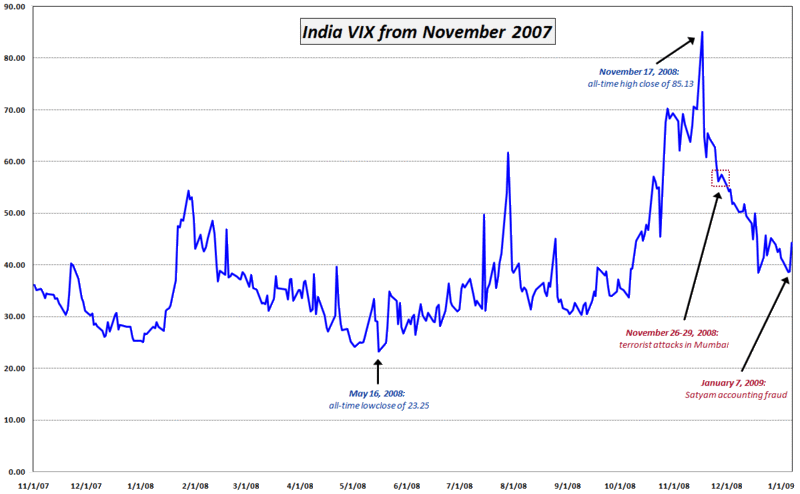Satyam, Fraud, and the India VIX
Today’s announcement that Satyam (SAY), the Indian outsourcing giant, has been engaged in a massive accounting fraud over the course of several years sent Satyam down 78% in local trading and dragged the Bombay Sensex down 7.3%.
All things considered, I was once again surprised by the relatively small spike in the India VIX, which jumped 14.5% to close at 44.36.
In the chart below I have plotted the course of the India VIX since November 2007 (the index launched in April 2008, but historical data has been reconstructed extending back another six months.) I find it interesting that the scale of the India VIX is not that much different than that of its U.S. counterpart. I also find it interesting that concerns about the global financial crisis in October 2008 was responsible for the peak in the volatility index, while the Mumbai terrorist attacks the following month barely register as a blip on the chart.
It remains to be seen what sort of long-term fallout the Satyam fraud will have on Indian equities, but so far the reaction has to be considered a relatively muted one.
Keep in mind that after many failed attempts at a bottom in 2001 and 2002, the NASDAQ did not put in a bottom until just after the WorldCom bankruptcy filing.



5 comments:
Interesting. It seems that recent India sentiment is just as complacent as ours. I'm asking myself if there is some kind of worldwide undercurrent that shapes these things (à la Obi Wan) or does the US behemoth simply bully all the other markets. Can you do any correlation studies on different countries or is the data even available?
Good question, John. Sounds like a problem for the Global Volatility Index.
Let me do some work on the components of that index and see what conclusions I can tease out.
In the past I noted some interesting divergences with the likes of South Korea when they were having severe problems, as well as Australia with their reliance on commodities and sky housing market. Canada also seems to go its own way, following energy prices.
Cheers,
-Bill
I'm suspecting that there's been a systemic change in what goes into VIX (worldwide) and how extremes should be assessed. That might be because the fungibility and liquidity of so many derivatives that hitherto would have been arbitraged has been impaired; e.g., Lehman and hedge funds aren't around to buy, write and make markets.
It’s a big blow to the Indian economy. Sentiments of all investors particularly FIIs is dampened. It will have dominos effect and the maket may collapse due to selling from all quarters, particularly FIIs. Its time that the powers-to-be plung into action and to take damage control before it has cascding effect. Some one should come forward to take care of the 50,000+ innocent employees and their families.
Satyam-What business demands????? puts not only the stakeholders but also lots of other in grave dillema.
I have written about it in http://controversial-affairs.blogspot.com/2009/01/what-business-demand.html
Post a Comment